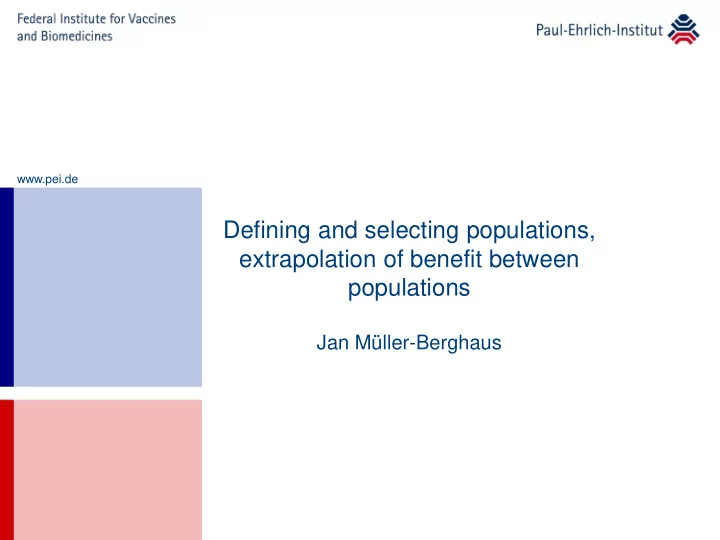

www.pei.de Defining and selecting populations, extrapolation of benefit between populations Jan Müller-Berghaus
SmPC guideline The indication(s) should be stated clearly and concisely and should define the target disease or condition distinguishing between treatment (symptomatic, curative or modifying the evolution or progression of the disease), prevention (primary or secondary) and diagnostic indication. When appropriate it should define the target population especially when restrictions to the patient populations apply. 2
Trial population Trial population Total (treatment naïve) population 3
Trial Failure on standard of care population Trial population 4
Failure on standard of care Trial population Trial population 5
C3 C1 D Standard of care B E C2 C4 6
Treatment paths of individuals A A+B A+C1 A+C2 A+D A E A+C1 A+C2 B C1 D E F B 7
What is the goal? Provide good evidence for safety and efficacy in patients with RA Come to conclusions for a population as broad as possible Provide options for patients Not unnecessarily restrict prescribers Minimise unnessary exposure of patients in clinical trials Placebo controls 8
What are the challenges? Disease is heterogenous per se Individual patients are being treated based on prognostic risk factors and clinical response with different drugs in different sequences The availability of several pharmacological treatment options make it more difficult to define „treatment lines“ now Response of patients to treatment varies Structural progression despite clinical response is possible To what degree do we need to differentiate subpopulations especially based on prior therapy? To what degree can we extrapolate between populations 9
General approaches Recruit „all comers“ i.e. heterogenous population How to handle inconsistent results in subpopulations? Power in relevant subpopulations reduced Recruit „subpopulations“ in different trials Which are the relevant subpopulations? How many subpopulations are required? 10
Approaches D F A+C1 A+D A A+B A+C2 A+C1 A+C3 E 11
Approaches D F A+C1 A+D A A+B A+C2 A+C1 A+C3 E 12
Approaches D F A+C1 A+D A A+B A+C2 A+C1 A+C3 E 13
Extrapolation External validity = „To whom do these results apply?“ There is no objective methodology to determine and establish external validity Ultimately it is the perceived benefit/risk balance for the population that is described in section 4.1 Available data are presented in section 5.1 of the SmPC Discussion on the extrapolation should be part of the EPAR There is no „one-size fits all“ approach 14
Questions Are there distinct subpopulations in RA? Which important (sub)populations should be included in a development program? To what extent is extrapolation possible? Is there a specific „direction“ of extrapolation? What data are required to be confident in extrapolation? 15
16
Recommend
More recommend